10.07.2022
Cosmic targets for Webb Telescope’s first images announced

The NASA/ESA/CSA James Webb Space Telescope will soon reveal unprecedented and detailed views of the Universe, with the upcoming release of its first full-colour images and spectroscopic data.
Below is the list of cosmic objects that Webb targeted for these first observations, which will be released in a live broadcast beginning at 16:30 CEST Tuesday, July 12. Each image will simultaneously be made available on social media as well as on partner agency’s websites. ESA will host the images here.
These listed targets below represent the first wave of full-colour scientific images and spectra the observatory has gathered, and the official beginning of Webb’s general science operations. They were selected by an international committee of representatives from NASA, ESA, CSA, and the Space Telescope Science Institute.
- Carina Nebula
The Carina Nebula is one of the largest and brightest nebulae in the sky, located approximately 7,600 light-years away in the southern constellation Carina. Nebulae are stellar nurseries where stars form. The Carina Nebula is home to many massive stars, several times larger than the Sun.
- WASP-96b (spectrum)
WASP-96b is a giant planet outside our Solar System, composed mainly of gas. The planet, located nearly 1,150 light-years from Earth, orbits its star every 3.4 days. It has about half the mass of Jupiter, and its discovery was announced in 2014.
- Southern Ring Nebula
The Southern Ring, or “Eight-Burst” nebula, is a planetary nebula – an expanding cloud of gas, surrounding a dying star. It is nearly half a light-year in diameter and is located approximately 2,000 light years away from Earth.
- Stephan’s Quintet
About 290 million light-years away, Stephan’s Quintet is located in the constellation Pegasus. It is notable for being the first compact galaxy group ever discovered. Four of the five galaxies within the quintet are locked in a cosmic dance of repeated close encounters.
- SMACS 0723
Massive foreground galaxy clusters magnify and distort the light of objects behind them, permitting a deep field view into both the extremely distant and intrinsically faint galaxy populations.
The release of these first images marks the official beginning of Webb’s science operations, which will continue to explore the mission’s key science themes. Teams have already applied through a competitive process for time to use the telescope, in what astronomers call its first “cycle,” or first year of observations.
How to follow the release of Webb’s first images via ESA channels.
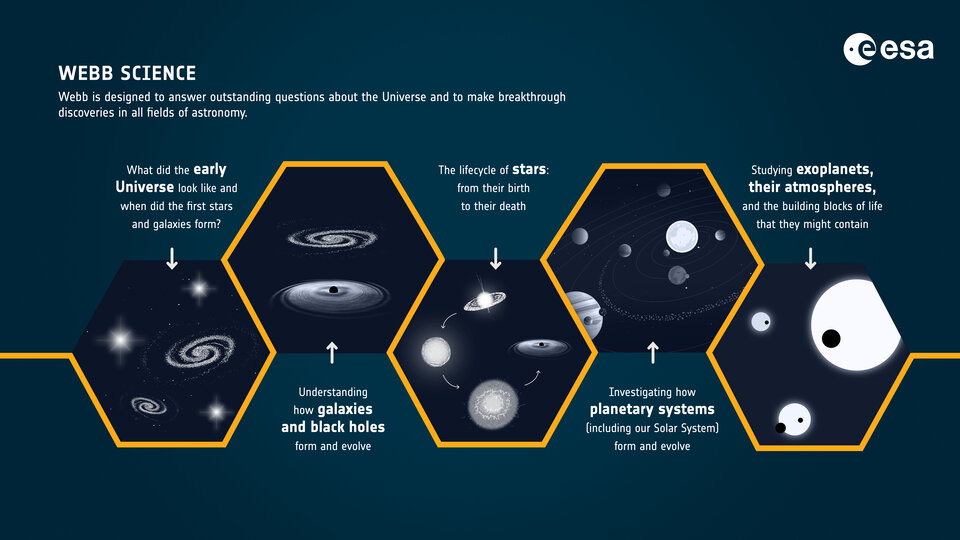
About Webb
The Webb telescope lifted off on an Ariane 5 rocket from Europe’s Spaceport in French Guiana on 25 December 2021 on its exciting mission to unlock the secrets of the Universe. Webb, a partnership between NASA, ESA and the Canadian Space Agency (CSA), is designed to answer outstanding questions about the Universe and to make breakthrough discoveries in all fields of astronomy. The major contributions of ESA to the mission are: the NIRSpec instrument; 50% of the MIRI instrument; the provision of the launch services; and personnel to support science operations. In return for these contributions, European scientists will get a minimum share of 15% of the total observing time, like for the NASA/ESA Hubble Space Telescope.
Quelle: ESA
----
Update: 12.07.2022
.
First Images from the James Webb Space Telescope
On Monday, July 11, President Joe Biden released one of the James Webb Space Telescope’s first images in a preview event at the White House in Washington. NASA, in partnership with ESA (European Space Agency) and CSA (Canadian Space Agency), will release the full set of Webb’s first full-color images and spectroscopic data during a televised broadcast beginning at 10:30 a.m. EDT (14:30 UTC) on Tuesday, July 12, from NASA’s Goddard Space Flight Center in Greenbelt, Maryland. Learn more about how to watch.
This first image from NASA’s James Webb Space Telescope is the deepest and sharpest infrared image of the distant universe to date. Known as Webb’s First Deep Field, this image of galaxy cluster SMACS 0723 is overflowing with detail. Thousands of galaxies – including the faintest objects ever observed in the infrared – have appeared in Webb’s view for the first time. This slice of the vast universe covers a patch of sky approximately the size of a grain of sand held at arm’s length by someone on the ground. Learn more about this image (en español).
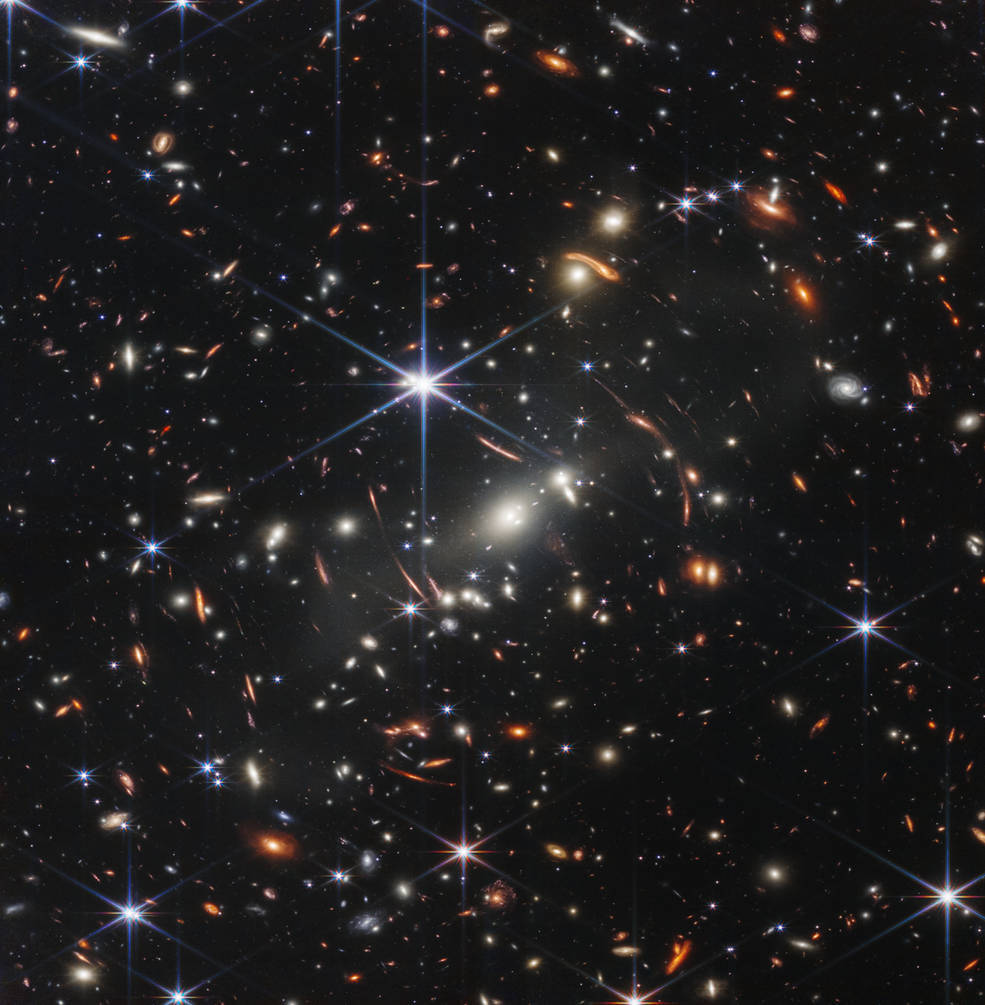
- President Joe Biden unveiled this image of galaxy cluster SMACS 0723, known as Webb’s First Deep Field, during a White House event Monday, July 11
- Webb’s image covers a patch of sky approximately the size of a grain of sand held at arm’s length by someone on the ground – and reveals thousands of galaxies in a tiny sliver of vast universe
- Webb’s sharp near-infrared view brought out faint structures in extremely distant galaxies, offering the most detailed view of the early universe to date
- NASA and its partners will release the full series of Webb’s first full-color images and data, known as spectra, Tuesday, July 12, during a live NASA TV broadcast
NASA’s James Webb Space Telescope has produced the deepest and sharpest infrared image of the distant universe to date. Known as Webb’s First Deep Field, this image of galaxy cluster SMACS 0723 is overflowing with detail.
Thousands of galaxies – including the faintest objects ever observed in the infrared – have appeared in Webb’s view for the first time. This slice of the vast universe covers a patch of sky approximately the size of a grain of sand held at arm’s length by someone on the ground.
This deep field, taken by Webb’s Near-Infrared Camera (NIRCam), is a composite made from images at different wavelengths, totaling 12.5 hours – achieving depths at infrared wavelengths beyond the Hubble Space Telescope’s deepest fields, which took weeks.
The image shows the galaxy cluster SMACS 0723 as it appeared 4.6 billion years ago. The combined mass of this galaxy cluster acts as a gravitational lens, magnifying much more distant galaxies behind it. Webb’s NIRCam has brought those distant galaxies into sharp focus – they have tiny, faint structures that have never been seen before, including star clusters and diffuse features. Researchers will soon begin to learn more about the galaxies’ masses, ages, histories, and compositions, as Webb seeks the earliest galaxies in the universe.
This image is among the telescope’s first-full color images. The full suite will be released Tuesday, July 12, beginning at 10:30 a.m. EDT, during a live NASA TV broadcast. Learn more about how to watch.
Image credit: NASA, ESA, CSA, and STScI
The James Webb Space Telescope is the world's premier space science observatory. Webb will solve mysteries in our solar system, look beyond to distant worlds around other stars, and probe the mysterious structures and origins of our universe and our place in it. Webb is an international program led by NASA with its partners, ESA (European Space Agency) and CSA (Canadian Space Agency).
NASA Headquarters oversees the mission for the agency’s Science Mission Directorate. NASA’s Goddard Space Flight Center in Greenbelt, Maryland, manages Webb for the agency and oversees work on the mission performed by the Space Telescope Science Institute, Northrop Grumman, and other mission partners. In addition to Goddard, several NASA centers contributed to the project, including the agency’s Johnson Space Center in Houston; Jet Propulsion Laboratory (JPL) in Southern California; Marshall Space Flight Center in Huntsville, Alabama; Ames Research Center in California’s Silicon Valley; and others.
NIRCam was built by a team at the University of Arizona and Lockheed Martin’s Advanced Technology Center.
Download full-resolution, uncompressed versions at https://webbtelescope.org/news/first-images.

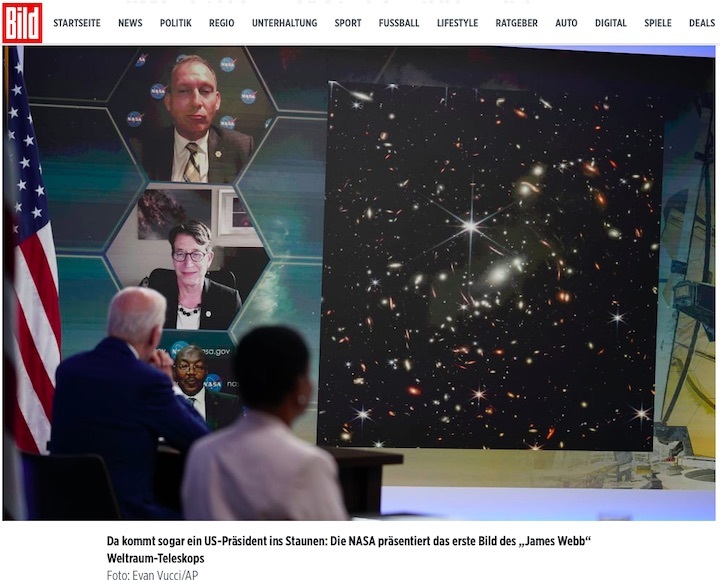
Wir blicken fast bis zum Urknall ...
Gemeinsam mit US-Präsident Joe Biden (79) und Vize Kamala Harris (57) hat die US-Raumfahrtbehörde Nasa am Montagnachmittag (Ortszeit) das erste vom Weltraumteleskop „James Webb“ aufgenommene Bild veröffentlicht.
Dieses erste Bild ist das bisher tiefste und schärfste Infrarotbild des fernen Universums. Es zeigt den Galaxienhaufen „SMACS 0723“, auch bekannt als Webb's First Deep Field, mit tausende von Sternen und Galaxien – darunter die schwächsten Objekte, die jemals im Infraroten beobachtet wurden.
Unglaublich: Der Ausschnitt des riesigen Universums bedeckt einen Himmelsausschnitt, der etwa so groß ist wie ein Sandkorn, das man auf Armeslänge an den Boden hält.
Das James Webb-Weltraumteleskop ist das größte und leistungsstärkste der Welt. Die Farbbilder seien von Vertretern verschiedener an dem Projekt beteiligter Raumfahrtagenturen ausgewählt worden und zeigten unter anderem den sogenannten Carinanebel, eine Art Gaswolke, und den außerhalb unseres Sonnensystems gelegenen Planeten „Wasp-96 b“, berichtet die NASA.
Biden sprach von einem „historischen Tag“, Harris von einem „aufregenden neuen Kapital in der Erforschung unseres Universums“. Am Dienstag (ab 16.30 Uhr Ortszeit) plant die NASA, weitere von dem Teleskop aufgenommene Bilder zu veröffentlichen.
James Webb war am 25. Dezember 2021 an Bord einer Ariane-Trägerrakete vom europäischen Weltraum-Bahnhof Kourou in Französisch-Guayana ins All gestartet. Während des rund vier Wochen langen Flugs wurden unter anderem der Sonnenschutz des Teleskops aufgespannt und die Spiegelsysteme ausgefahren. Im Januar erreichte „James Webb“ dann seinen Zielorbit, danach richtete es seine Spiegelsegmente aus und testete sie.
Wissenschaftler erhoffen sich von den Aufnahmen des Teleskops unter anderem Erkenntnisse über die Zeit nach dem Urknall vor rund 13,8 Milliarden Jahren. James Webb wurde rund 30 Jahre lang entwickelt und kostete etwa zehn Milliarden Dollar. Es folgt auf das Teleskop Hubble, das seit mehr als 30 Jahren im Einsatz ist.
Quelle: Bild
----
Update: 13.07.2022
.
NASA releases first color image from James Webb Space Telescope
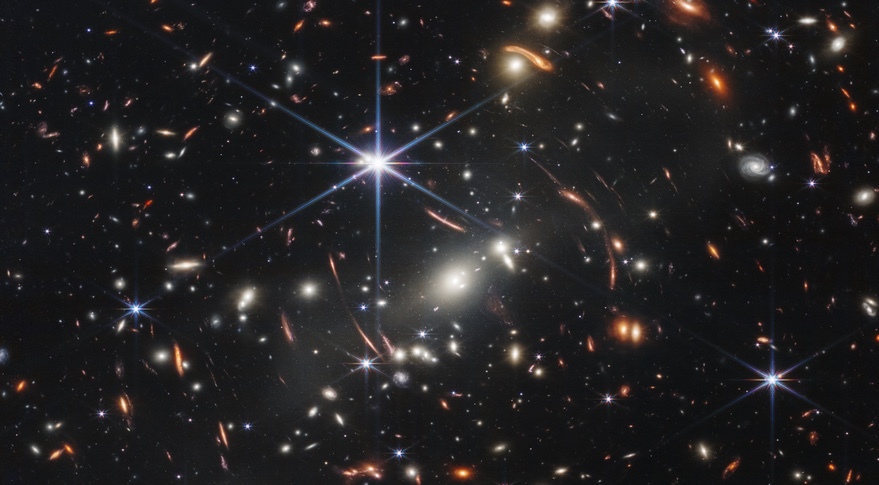
WASHINGTON — A deep field of distant galaxies, some dating back to the first billion years after the Big Bang, is the first full-color image to come from the James Webb Space Telescope.
The image, released at a White House event July 11 and called “Webb’s First Deep Field,” is a sneak preview of a broader set of early release observations that NASA and its European and Canadian partners on JWST plan to publish July 12. The White House event, attended by President Joe Biden and Vice President Kamala Harris, was announced with less than 24 hours’ notice.
The image shows a galaxy cluster called SMACS 0723 about 4.5 billion light-years away. The cluster acts as a gravitational lens, bringing into view far more distant galaxies, some of which appear in the image as arcs.
“We’re looking back more than 13 billion years,” said NASA Administrator Bill Nelson at the event. The NASA statement accompanying the image release didn’t give specifics on the more distant galaxies visible in the image, which involved 12.5 hours of images taken at several wavelengths. The Big Bang took place an estimated 13.8 billion years ago, meaning those distant galaxies date back to when the universe was less than a billion years old.
The detail in the image comes from a very tiny part of the sky. “If you held a grain of sand on the tip of your finger at arm’s length, that is the part of the universe you’re seeing. Just one little speck of the universe,” Nelson said.
Biden appeared pleased by what he saw and by the performance of JWST. “It symbolizes the relentless spirit of American ingenuity and it shows what we can achieve, what more we can discover,” he said of the space telescope, which finally launched last December after billions of dollars of cost overruns and years of schedule delays. JWST is now working better than expected at the Earth-sun L-2 point 1.5 million kilometers away. “These images are going to remind the world that America can do big things.”
“This telescope is one of humanity’s great engineering achievements,” added Harris. Both she and Biden emphasized the role of international cooperation in JWST’s development, including how, according to Harris, “a scientific endeavor can build upon the international rules and norms that govern our cooperation in space.”
The White House event started more than an hour later because, Biden said, he was busy preparing for an upcoming trip to the Middle East. Media were ushered out of the room and the webcast ended after only about 10 minutes.
Scientists and others were immediately impressed, though, with the image. “This is just a first glimpse of what Webb can do,” said Macarena Garcia Marin, ESA instrument scientist for a mid-infrared instrument on JWST called MIRI, in an ESA statement. “While we are truly in awe today of Webb’s first deep field, I can’t help but think of what images and science results are just around the corner in the many years to come.”
“The first image from the James Webb Space Telescope unveiled this evening is an incredible preview of its remarkable technology and scientific power,” said Rep. Eddie Bernice Johnson (D-Texas), chair of the House Science Committee, in a statement that featured bipartisan praise of the spacecraft from the committee’s leadership. “As a steadfast supporter of Webb and its mission, I am elated to see this image today — an image that has been 20 years of hard work in the making.”
The deep field image was originally scheduled to be released July 12 with the other early release observations. NASA and its partners will still release those other observations at that event. The other observations, announced by NASA July 8, include the Carina Nebula and Southern Ring Nebula within our own galaxy and the galaxy group Stephan’s Quintet about 290 million light-years away. NASA will also release spectra of the exoplanet WASP-96b, a “hot Jupiter” planet orbiting close to its star.
Quelle: SN
+++
Webb delivers deepest infrared image of Universe yet in special briefing
The international NASA/ESA/CSA James Webb Space Telescope has delivered the deepest, sharpest infrared image of the distant Universe so far.
U.S. President Joe Biden unveiled the image of galaxy cluster SMACS 0723, known as Webb’s First Deep Field, during a White House event on Monday 11 July.
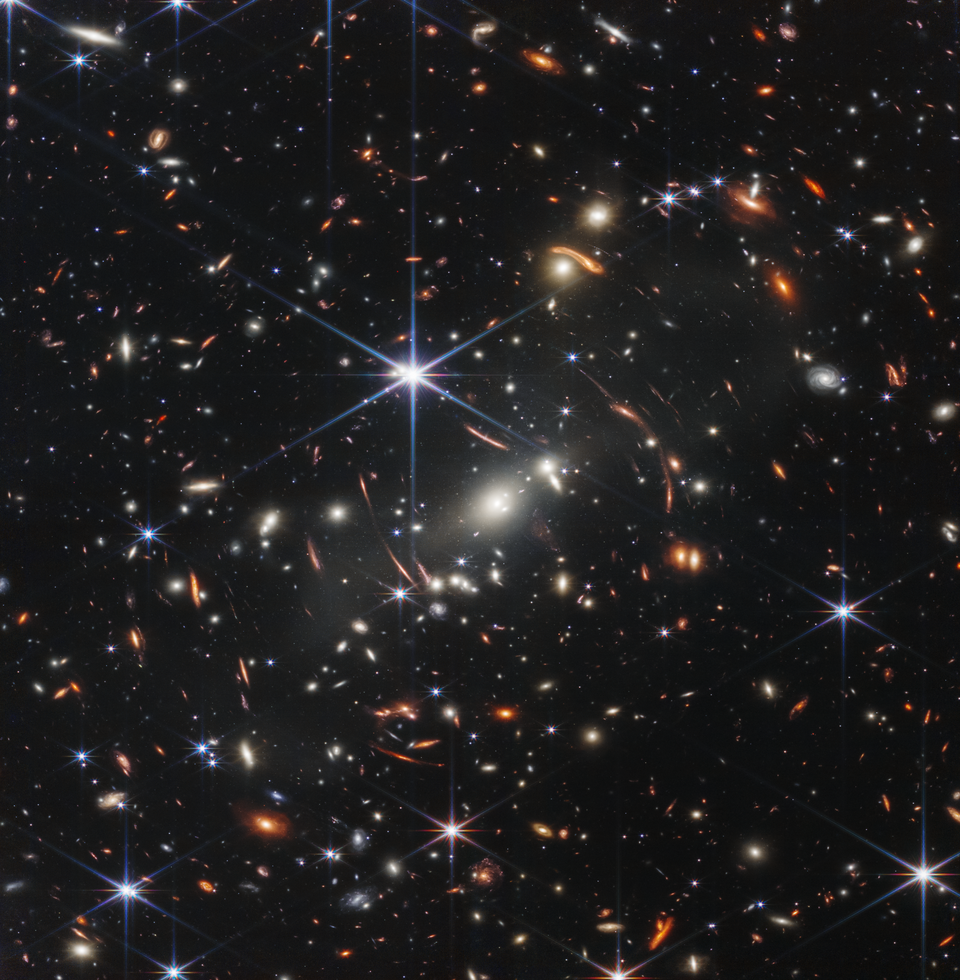
"Webb's First Deep Field is not only the first full-colour image from the James Webb Space Telescope, it’s the deepest and sharpest infrared image of the distant universe, so far. This image covers a patch of sky approximately the size of a grain of sand held at arm’s length. It’s just a tiny sliver of the vast Universe," said NASA Administrator Bill Nelson.
“This mission was made possible by human ingenuity – the incredible NASA Webb team and our international partners at the European Space Agency and the Canadian Space Agency. Webb is just the start of what we can accomplish in the future when we work together for the benefit of humanity."
“What an incredible honour for ESA and its international partners to reveal Webb’s first image from the White House,” says ESA Director General Josef Aschbacher.
“Only with teamwork, dedication, and the human drive to push boundaries and explore have we arrived at this historical moment of seeing the deepest view of the early Universe to date.”
Known as Webb’s First Deep Field, this image of galaxy cluster SMACS 0723 is overflowing with detail.
“We are now even more excited for tomorrow’s release of further images and spectra from ESA-contributed instruments, which add another dimension to the Deep Field and the other stunning cosmic targets,” says ESA’s Director of Science, Günther Hasinger. “We are ready to begin our voyage back to the early days of our Universe with this world-class observatory.”
“This is just a first glimpse of what Webb can do," says Macarena Garcia Marin, MIRI ESA Instrument Scientist. "While we are truly in awe today of Webb's first deep field, I can’t help but think of what images and science results are just around the corner in the many years to come!”
This image is among the telescope’s first-full colour images. The full suite will be released Tuesday 12 July, beginning at 16:30 CEST (a leadership address will be aired beforehand, at 15:45 CEST, and a media briefing will follow at 18:30 CEST). Find out how to follow on ESA's channels here.
About Webb
Webb is the largest, most powerful telescope ever launched into space. Under an international collaboration agreement, ESA provided the telescope’s launch service, using the Ariane 5 launch vehicle. Working with partners, ESA was responsible for the development and qualification of Ariane 5 adaptations for the Webb mission and for the procurement of the launch service by Arianespace. ESA also provided the workhorse spectrograph NIRSpec and 50% of the mid-infrared instrument MIRI, which was designed and built by a consortium of nationally funded European Institutes (The MIRI European Consortium) in partnership with JPL and the University of Arizona.
Quelle: ESA
